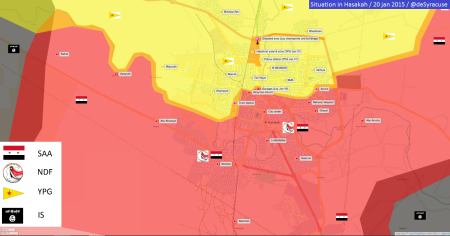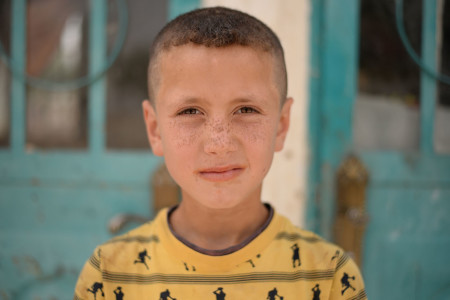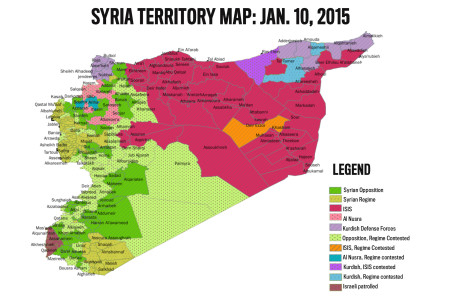Katy Montoya, an undergraduate at Swarthmore College, has undertaken some ambitious research on the situation of Syrian refugees in Jordan. Following previous work on refugees in Jordan posted on Syria Comment (here, here, and here), some excerpts of Katy’s work are re-posted below; read her entire research article at the Institut de recherches et d’études sur le monde arabe et musulman. Follow Katy: @K4TYMONTOYA

… Jordanian policies toward entering and residing Syrians have evolved simultaneously with the three-and-a-half year conflict. Jordanian border security has, from the beginning, played a generous role in facilitating border crossings, ending the long, often dangerous journeys of fleeing Syrians. Various Jordanian officials in my interviews emphasized the extent of humanitarian care that Jordan provides for entering Syrians, in partnership with the UN High Commissioner for Refugees (UNHCR), from the border in. Unlike nearby Lebanon, the Jordanian government has worked with the UNHCR to open the al-Za’tari and al-Azraq refugee camps. Other camps include Cyber City, a holding facility for “illegal” Palestinian refugees from Syria (often referred to as PRS) and the Emirati (UAE-funded) camp.
Keeping a close count of registered Syrian refugees is difficult. Many Syrians enter Jordan illegally by bypassing official checkpoints. Increasingly, this is due to intensifying battles over border crossings between Jabhat an-Nusra, the Free Syrian Army, and al-Asad’s forces, and Jordan’s subsequent closing of bordering crossings.[5] Meanwhile, about a hundred thousand Syrians who once resided in Jordan’s refugee camps have voluntarily returned to Syria. Many have also escaped the camps for Jordan’s cities and rural areas in order to seek better conditions and work opportunities.[6] Thus, roughly twenty percent of Syrians in Jordan face poor camp conditions.[7] Overcrowding and poor sanitation prevail, especially in the al-Za’tari and Cyber City camps, despite the efforts of camp officials.
Meanwhile, eighty percent of Syrians now live outside Jordan’s refugee camps and struggle to obtain necessary goods and services. With the help of UN subsidies, Jordan has kept its public hospitals open to Syrian refugees for over three years, allowing refugees to access free healthcare. State officials abruptly announced the termination of these services in late November 2014, citing the heavy debts Jordan has accrued through extending free Health-care to Syrian refugees.[8] …
… During the summer of 2014, rumors began to circulate in the international media concerning Jordan’s repatriation of illegal Syrian workers and the strict cap imposed on Syrian refugees awaiting entry at the border. Syrian social workers reported cases of Jordanian authorities forcefully relocating unregistered urban refugees to live in refugee camps. The interviews I conducted this summer with Syrian social workers upheld such claims. Meanwhile, the official Jordanian press denied Jordan’s involvement in deporting refugees back to Syria.[9] Months later, however, international organizations and researchers have indeed been able to substantiate the claims.
A November 2014 report released by Boston University (BU) compiles interviews with international organizations and the testimonials of impacted Syrians, providing conclusive evidence of Jordan’s practice of forced repatriation. In fact, escalating concerns over refugee control and domestic security have created a charged political climate surrounding these matters. It is becoming clear that new security priorities have prompted Jordanian authorities to deport threatening and nonthreatening Syrian refugees alike. As the BU report states, “Syrian nationals are being deported in some instances for violating laws, such as working illegally. Others are deported for posing security problems, usually as a result of political action, regardless of specific affiliation.”[10] Through this practice, Jordan may damage its international image, even though it is true that the kingdom is not a signee of the 1951 Refugee Convention. As my initial research problematic hypothesized, security concerns have come to dominate the Jordanian government’s approach to hosting Syrian refugees.
A Survey of Syrian Social Networks in Jordan
In his study of Islamist organizations in Jordan, Quintan Wiktorowicz concludes that the Jordanian state exercises authoritarian control over civil society formation and practices.[12] Jordan’s General Intelligence Directorate, the Mukhabarat, are a major force in regulating the contents and activities of political parties, charities, and cultural organizations. While this holds true for Jordanian organizations, I discovered through my survey of civil society formation in Syrian refugee communities, that among this population, Jordan is only selectively regulatory. In other words, the state allows some organizations and groups to operate freely while others are closely monitored or banned altogether. An exploration of what is permitted, and under what conditions, should contribute to reveal the logic which is currently steering Jordan’s refugee policy, and by extension, what its political position towards the Syrian war may be. …
… In Irbid, the only surviving Syrian family support center (as of July 2014) has gone to a lot of trouble to abide by strict regulation requirements. The founder (a former activist from Dera’a) not only has sought the assistance of a European NGO partner, but also created two salaried positions for Jordanian workers, a heavy burden for a struggling non-profit, in order to justify its right to operate in Jordan. “If I didn’t do this, the authorities would close me down immediately,” she explained, referring to Jordan’s Ministry of Social Development. …
… Another member of the Syrian community in Irbid has established a sort of civil registry office in his living room, reprinting legal documents for Syrians who left their papers behind or whose documents have expired. Syrians come to his home office from various communities in North Jordan, seeking his services. For over a year, he has also assembled teams of Syrian activists to document human rights violations and civilian deaths wherever they have occurred in Syria. Volunteers in his office use testimonies and different methods of verification to create reports with titles like, “Violence Against Girls and Women in Dera’a” and “Attacks on Field Hospitals in Aleppo.”
The founder claims that when his documents first began surfacing, their factsWere at variance with the information published by the Syrian National Coalition (SNC). He relates this to the Jordanian Mukhabarat’s attempts to shut down his center—that is, until the Jordanian authorities had assessed the quality of his work. He provides legal documents in the hope they will be recognized by the Jordanian government and by international organizations. Meanwhile, his human rights work ties his center to political leaders, various armed opposition groups, journalists, activists, arms-traffickers, and local coordinating committees in Syria and neighboring countries. The capacity to obtain quantifiable evidence on events in Syria from Jordan is a testament to the organization and coherence of the transnational networks which bind the larger Syrian community together.
Extending Support to Non-Civilians
The informal networks that include non-civilians, particularly those that connect Syrian refugee communities to armed opposition groups in Syria, work in fairly similar ways. As Syrians collectivize to address civilian needs, it is not uncommon for them to engage with Syrians who have political and military affiliations. In my own experiences of visiting ostensibly civilian Syrian community centers, I encountered individuals who play more direct roles in the Syrian opposition on a regular basis: field doctors from battle sites in Dera’a, leaders of different divisions of South Syria’s FSA, prominent political activists and dissidents, and arms collectors. They often share family or hometown ties to Syrian community leaders in Jordan and use the resources made available by community networks to collect funds and supplies, relocate their families to Jordan, spread news, and discuss opposition strategies. As more Syrians flee to Jordan, the dynamics of civilian versus non-civilian have become increasingly complex. …
… The relative ease with which Syrians in Jordan connect with and support members of Syria’s opposition occurs in the context of implicitly partisan (non-neutral) practices. It is relatively well-known that the Syrian-Jordanian borders are spaces of cooperation between the Jordanian military and the FSA. My interviews with leaders of South Syria’s Military Council (i.e. the FSA), as well as with various media sources, confirm that implicit agreements between these military groups enable the free movement of FSA leaders across the border. Moreover, at one of the last border crossings to remain open at Ruwaishid, Jordanian intelligence and military actively facilitate the transport of arms, food, and medical supplies across the border into Syria, as well as the entry of refugees into Jordan.[14] …
… The same standard applies to Jordan, as the kingdom has exercised diplomatic caution since early on in the conflict and claims to be a neutral bystander in the ongoing war.[16] In this context, the overlaps and contradictions between caring for Syrian civilians and managing the interests of the Syrian opposition are constant and ongoing. Keeping non-civilians out of Jordan becomes more complicated when dealing with Syrians who haven’t deliberately left their homes for Jordan (and are not actively seeking refugee status) but rather have been rushed to the borders by the FSA. As war casualties, they come from both civilian neighborhoods and from the battlefield, and their injuries largely exceed the capacities of Syrian field hospitals.
Although the Jordanian military and intelligence employ strict identification screening methods throughout the registration process for refugees, they generally apply much looser policies to Syrian casualties seeking medical treatment. The procedures set up to manage this influx supposedly privilege civilian victims and Syria’s moderate opposition (the FSA), yet Jordan’s open-door policy inadvertently extends to wounded fighters from al-Qaida’s affiliate, Jabhat an-Nusra, and possibly other groups active in Syria’s southern region.
Jordanian security, intelligence, and medical personnel are undoubtedly aware of this. Officials actively control the movement of Syrian trauma patients in Jordan in order to counterbalance their humanitarian open-door policies. Such practices were common when Palestinian refugees from Iraq living in Jordan’s Ruwaishid camp use to seek medical treatment in Jordan’s cities after the US invasion in 2003.[17] Today, members of Jordan’s Civilian Defense escort wounded Syrians to their first stop at the public Ramtha Government Hospital. From there, police officers supervise each patient’s stay, whether unaccompanied male or patient plus family, at one of the country’s several private, specialized hospitals. This route officially terminates at the Joint Registration Center at Ruba’a al-Sarhan, close to the Syrian border in the al-Mafraq governorate. There, individuals are registered and officials assess whether they should be sent to al-Za’tari camp (to be escorted by police to further medical appointments at a later date) or back to the dangerous zones in Syria from where they came.
The movement of Syrians through informal social networks is much harder for Jordan to regulate. Loopholes exist in the surveillance procedures that the state increasingly imposes on Syrian refugees. While Jordanian officials claim it is not possible for recovering Syrian trauma patients to evade the regulated system that leads them to al-Za’atari or back to Syria, certain intermediaries intervene on the behalf of these vulnerable individuals. One such Jordanian, bearing the pseudonym Abu Ahmad, a man from Zarqa City, works full-time in the service of the Syrian community. Since retiring from decades of membership in Jordanian Security, he has used his wasta, a cultural term denoting extensive social connections and a certain privilege and status, to pull young Syrian men out of this often merciless system. He frequently visits al-Za’tari Camp and private hospitals to follow up on special cases that come to his attention through his ties to the greater Syrian community. By mobilizing funds from wealthy Syrian donors abroad, he has established housing units for disabled ex-FSA fighters that provide ongoing medical treatment and rehabilitation as well as living necessities. Even as a well-established East-Bank Jordanian, he is subject to monitoring by the Jordanian authorities. Abu Ahmad explains that the authorities’ primary concern is ensuring that only moderate Syrian nationals—not extremist fighters, Palestinian refugees from Syria, or foreign fighters—find refuge in Jordan.
Jordan has, perhaps, overcompensated to dispel rumors suggesting that it is providing refuge to non-moderate armed oppositions groups. At the same time, the evolution of its policies toward Syrian refugees reflects the increasing security concerns at its borders. An article from the Forced Migration Review notes that since 2013, “Jordan has imposed bans on unaccompanied men from entering the country.”[18] The rising threat of Islamic State fighters entering the country compounds existing fears of Syrian regime agents penetrating the closely monitored borders, as Jordanian border security officials explained to me. The same article describes a common occurrence in conflict-ridden countries, where a separate political logic often applies to male refugees of fighting age (as opposed to families, women, and children).[19] Specifically, host country policies toward adult males overemphasize their potential for taking up arms, and thus discriminate against them as assumed non-civilians. Scoping out possible threats to Jordan’s internal harmony and curbing extremism is increasingly being imposed at the expense of offering refuge to some of Syria’s most vulnerable displaced individuals. …

Victim of airstrike treated in ICU in Amman – Photo: IREMAM
Circles of Syrian Doctors Working in Jordan
… For over a year, it seemed that as long as Syrian doctors continued filling in for the lack of doctors treating incoming wounded Syrians, and as long as they steered clear of politics, the Jordanian government would continue to turn something of an acquiescent blind eye to these predominantly wageless doctors. However, an article by Human Rights Watch announced the recent deportation of Syrian medical workers “caught” treating Syrian patients at Ramtha Public Hospital as well as at private hospitals around Jordan.[21] It is safe to conclude that Jordanian authorities have already closed, or may soon close, rehabilitation centers and Syrian hospital wards which have provided the materials for a part of this present study.
Monitoring a Situation in Flux
Jordan’s steady deviation from humanitarian obligation reveals the Kingdom’s apprehensions about hosting another refugee population, on a long-term basis. It is indeed relevant to wonder whether Jordan’s growing impatience stems in fact from the utter lack of any solution to Syria’s persistent war. In the light of the escalating security concerns that cooperation with the FSA raises, perhaps the costs of quietly supporting Syria’s moderate opposition are too high. Through its recent political moves, Jordan may be seen to be sending an implicit message to the refugees and to the international community—that is, a desire to reduce involvement in Syrian affairs. However, could it also be that after three and a half years of conflict, the Jordanian government, like a significant number of Syrian refugees, is considering reconciliation with the al-Asad regime?[22]
Most importantly for this research, it is crucial to raise the question of just how far Jordan’s evolving political agenda will affect its treatment of Syrian refugees and the resulting wellbeing of these communities. Can their informal networks withstand repressive host country policies? How will underhand practices like repatriation undermine the resilience and cohesiveness of the larger Syrian community?
Life has come to a halt for Syrians in Jordan, who have little access to higher education, healthcare, and work. For many, Jordan is just a temporary stopover before the refugees move on to Turkey or undertake the dangerous trip to Europe. As European Union member countries and Australia are offering thousands of resettlement and asylum opportunities to Syrians, the common perception is that better treatment and possibilities are awaiting them there.[23] While Jordan is becoming an increasingly undesirable place for Syrians to live and be, most have no option but to stay put and wait it out.
Read the entire research article
 by Nicholas A. Heras
by Nicholas A. Heras
 Interviewing Asad
Interviewing Asad





 A report that outlines Iran and Hezbollah involvement in the conflict:
A report that outlines Iran and Hezbollah involvement in the conflict: 


 by Julio Rivera
by Julio Rivera

 By viewing the footage, IS does a kind of violence to me—or perhaps I am doing violence to myself by choosing to watch. There seems to be something problematic about becoming consumers of this horrific product that IS pushes. Does that extend to the political analyst? The intelligence analyst? Who legitimately needs to consume this product and who should not view it?
By viewing the footage, IS does a kind of violence to me—or perhaps I am doing violence to myself by choosing to watch. There seems to be something problematic about becoming consumers of this horrific product that IS pushes. Does that extend to the political analyst? The intelligence analyst? Who legitimately needs to consume this product and who should not view it?







